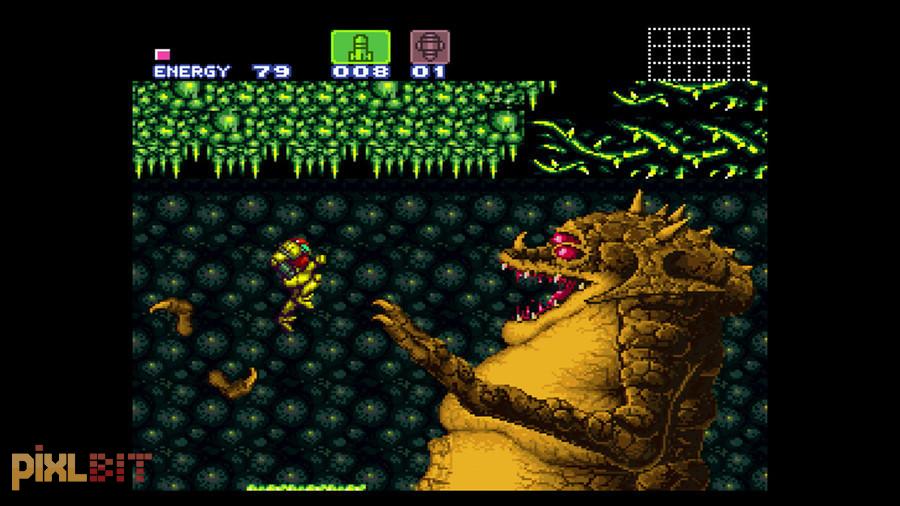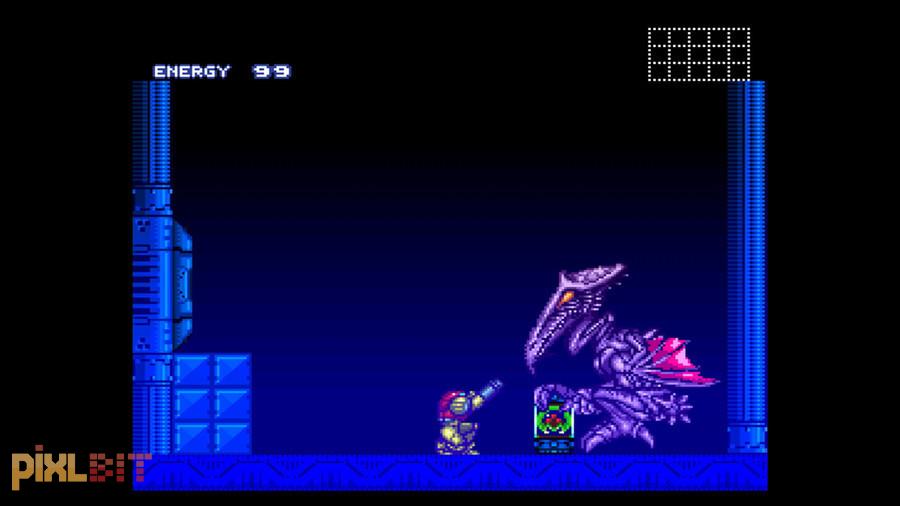
More stunning confessions from me to you! I didn’t get into the Metroid series until Metroid Prime and Metroid Fusion, and didn’t even play Super Metroid until maybe two years after I played Metroid Prime. While the first Prime title took many design inspirations from Super Metroid, I didn’t enjoy Super Metroid at first, mostly because I played it through less than reputable means. Once I got to play it on the Wii Virtual Console, I finally understood why this game is considered an SNES classic. Super Metroid sports great game design, with a wonderful atmosphere unparalleled on any 16-bit system. At only 30 cents on the Wii U eShop until June 16, there’s little reason to not give this excellent title a shot.
Unlike the second Metroid game on the Game Boy, which was a slightly more linear quest to eliminate Metroids, Super Metroid follows and expands upon the non-linear exploration that was found in the first game. Various areas on Zebes are inaccessible unless you have certain power ups at your disposal. While classic Metroid items like the Morph Ball, Ice Beam, and Missiles return, the power-ups Samus can collect have doubled. Famous Metroid items like the Power Bomb, Super Missiles, and Grapple Beam made their debut in this game, and they are used constantly in exploring new areas.

Coupled with the great level design, this emphasis on exploration is what made Super Metroid a classic. I got lost many times and had to backtrack to find new power-ups to advance, but it never got boring, because experimenting with Samus’ unlocked abilities further expanded my missile and power bomb count, as well as those all-important energy tanks. These upgrades are vital, because the enemies and bosses are now more of a threat; certain enemies cannot be destroyed without certain weapons or power-ups.
As much as I love Super Metroid, I deducted half a star from the overall score because while the gameplay is great, I took issue with some of the controls. This is one of those few SNES titles that utilize the entire SNES game pad, which can be optimized in the options menu before you start or restart your save file. As someone who enjoyed the simplistic controls in Metroid Fusion and Zero Mission, having to press ‘Select’ to cycle through your power ups on hand during a chaotic battle with either enemies or bosses lead to some frustration for me. Additionally, Samus’ speed boost can’t be activated unless the dash button is held down. While this is a minor inconvenience, my enjoyment of the streamlined controls of the GBA games made this stand out.
Visually, this game is a great showcase of the SNES’ abilities. While Donkey Kong Country became one of the most popular examples of visual and audio being done well on the SNES, in all honesty Super Metroid was a real showcase of what the SNES was capable of. Character sprites are animated extremely well with little tiny details showing in their movements and attacks, with bosses standing out as prime examples of its artistry. The various areas are crafted with tons of little touches in the backgrounds and foregrounds, with great use of Mode 7 effects to fit the brooding atmosphere of the game. Occasionally I encountered some slowdown, but it didn't occur often enough to be an issue, especially with the game's smooth frame rate.

This is easily my favorite SNES soundtrack; Kenji Yamamoto composed tons of mood-setting tunes for the game’s different areas, from entering the deserted surface of Zebes for the first time to the heart-pounding boss battle with Kraid. The sound design is executed well, from various laser blasts and explosions to Ridley’s trademark screech before attacking.
If you have not experienced Super Metroid yet, now is the time to do so; while I found the controls to be a little problematic, the entire experience is grand, making for one of the best games on the SNES. For thirty cents, this classic title is an absolute steal and deserves a spot on your Wii U menu. Buy it, you won’t regret it.
Review Policy
In our reviews, we'll try not to bore you with minutiae of a game. Instead,
we'll outline what makes the game good or bad, and focus on telling you whether
or not it is worth your time as opposed to what button makes you jump.
We use a five-star rating system with intervals of .5. Below is an outline of
what each score generally means:

All games that receive this score are
standout games in their genre. All players should seek a way to play this game.
While the score doesn't equate to perfection, it's the best any game could conceivably do.

These are above-average games that most players should consider purchasing. Nearly
everyone will enjoy the game and given the proper audience, some may even love these
games.

This is our middle-of-the-road ranking. Titles that receive three stars may not make
a strong impression on the reviewer in either direction. These games may have some
faults and some strong points but they average out to be a modest title that is at
least worthy of rental for most.

Games that are awarded two stars are below average titles. Good ideas may be present,
but execution is poor and many issues hinder the experience.

Though functional, a game that receives this score has major issues. There are little
to no redeeming qualities and should be avoided by nearly all players.

A game that gets this score is fundamentally broken and should be avoided by everyone.












 Haven't played it in probably in 15 years, so I'm looking forward to exploring the depths of Zebes again.
Haven't played it in probably in 15 years, so I'm looking forward to exploring the depths of Zebes again.


Comments